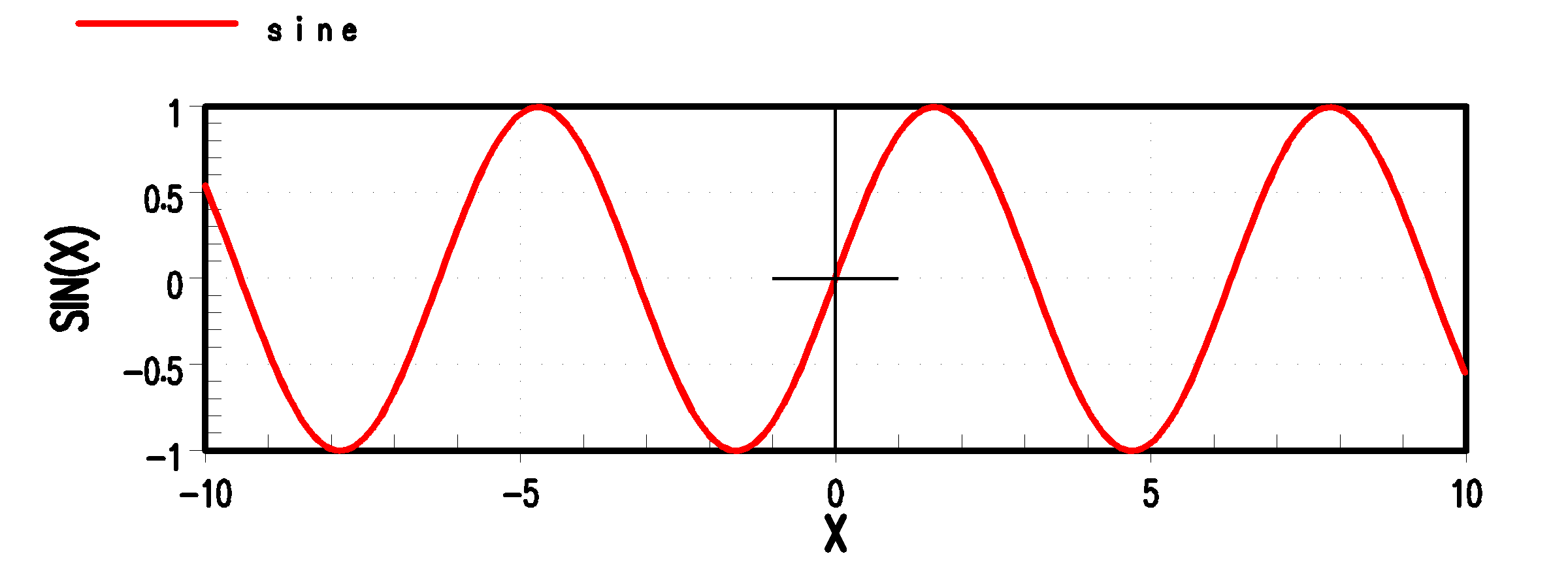Manual Reference Pages - sin (3fortran)
SIN(3) - [MATHEMATICS:TRIGONOMETRIC] Sine function
SYNOPSIS
result = sin(x)
elemental TYPE(kind=KIND) function sin(x)TYPE(kind=KIND) :: x
CHARACTERISTICS
o X may be any real or complex type o KIND may be any kind supported by the associated type of X. o The returned value will be of the same type and kind as the argument X.
DESCRIPTION
SIN(X) computes the sine of X, where X is an angle in radians. The result is a scalar or array of the same type and kind as X. For real inputs, the result is in the range [-1, 1]. For complex inputs, the sine is computed using the complex trigonometric definition. That is, for complex inputs,
SIN(X) = (EXP(i*X) - EXP(-i*X)) / (2*i)The sine of an angle in a right-angled triangle is the ratio of the length of the side opposite the given angle divided by the length of the hypotenuse.
For real inputs, ensure X is in radians, not degrees. Use
RADIAN = DEGREE * 3.14159265359 / 180.0for conversion.
where i is the imaginary unit. The result’s kind matches the input’s kind.
OPTIONS
o X : The angle in radians to compute the sine of.
RESULT
The return value contains the processor-dependent approximation of the sine of X
If X is of type real, it is regarded as a value in radians.
If X is of type complex, its real part is regarded as a value in radians.
EXAMPLES
Sample program:
program sample_sin implicit none real :: x = 0.0 x = sin(x) write(*,*)’X=’,x end program sample_sinResults:
> X= 0.0000000E+00Extended Example
Haversine Formula
From the article on "Haversine formula" in Wikipedia:
The haversine formula is an equation important in navigation, giving great-circle distances between two points on a sphere from their longitudes and latitudes.So to show the great-circle distance between the Nashville International Airport (BNA) in TN, USA, and the Los Angeles International Airport (LAX) in CA, USA you would start with their latitude and longitude, commonly given as
BNA: N 36 degrees 7.2’, W 86 degrees 40.2’ LAX: N 33 degrees 56.4’, W 118 degrees 24.0’which converted to floating-point values in degrees is:
o BNA latitude=36.12, longitude=-86.67 o LAX latitude=33.94, longitude=-118.40 And then use the haversine formula to roughly calculate the distance along the surface of the Earth between the locations:
Sample program:
program demo_sin implicit none real :: d d = haversine(36.12,-86.67, 33.94,-118.40) ! BNA to LAX print ’(*(A,1x,F9.4,1x))’,’distance:’,d,’km, or’,d*0.62137119,’miles’ contains function haversine(latA,lonA,latB,lonB) result (dist) ! ! calculate great circle distance in kilometers ! given latitude and longitude in degrees ! real,intent(in) :: latA,lonA,latB,lonB real :: a,c,dist,delta_lat,delta_lon,lat1,lat2 real,parameter :: radius = 6371 ! mean earth radius in kilometers, ! recommended by the International Union of Geodesy and GeophysicsResults:! generate constant pi/180 real, parameter :: deg_to_rad = atan(1.0)/45.0 delta_lat = deg_to_rad*(latB-latA) delta_lon = deg_to_rad*(lonB-lonA) lat1 = deg_to_rad*(latA) lat2 = deg_to_rad*(latB) a = (sin(delta_lat/2))**2 + & & cos(lat1)*cos(lat2)*(sin(delta_lon/2))**2 c = 2*asin(sqrt(a)) dist = radius*c end function haversine end program demo_sin
> distance: 2886.4446 km, or 1793.5536 miles
STANDARD
FORTRAN 77
SEE ALSO
ASIN(3), COS(3), TAN(3), ACOSH(3), ACOS(3), ASINH(3), ATAN2(3), ATANH(3), ACOSH(3), ASINH(3), ATANH(3)
RESOURCES
Fortran intrinsic descriptions (license: MIT) @urbanjost
o Wikipedia:sine and cosine
